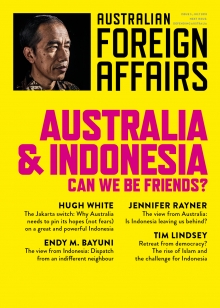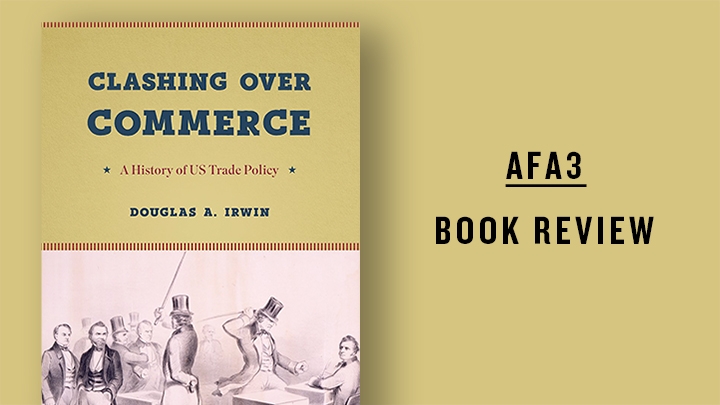
This review is featured in Australian Foreign Affairs 3: Australia and Indonesia.
To read the full issue, log in, subscribe or buy the issue.
Clashing over Commerce: A History of US Trade Policy
Douglas A. Irwin
University of Chicago Press
The world was surprised in 2016 by the election of New York property developer Donald J. Trump to the White House over Democrat establishment figure Hillary Clinton. Trump had never held elected office and had no fixed political allegiances, identifying as a Democrat in the 1980s before running as a Republican – albeit as a self-styled anti-establishment “outsider”. To be fair, Clinton had also switched sides, starting her life as Republican (a so-called “Goldwater girl”, supporting conservative presidential candidate Barry Goldwater in 1964) before becoming a Democrat and part of a political dynasty.
Perhaps less surprising was candidate Trump’s message in support of trade protectionism and isolationism, which helped him to secure the nomination and the election. This stance was also taken by left-winger Bernie Sanders in the Democratic primaries, forcing Clinton to reconsider her support for the Trans-Pacific Partnership (TPP) as she began to realise how much free trade was on the nose in the American electorate.
Trump ran very hard against free trade agreements – particularly the North American Free Trade Agreement and the TPP – claiming that China and other foreign powers were taking advantage of the United States through these “lousy” deals, which, as a successful businessman, he could renegotiate. Politically, this was aimed at the blue-collar industrial swing states, which eschewed Clinton and the “Corporate Democrats” and gave Trump the electoral college votes to get him to the White House. Hillary offered them lectures on misogyny and racism; Trump offered them tariff protection. Neither is going to help them in the long run, but tariff protection might help Trump – again – in 2020.
As president, Trump has upset financial markets and US trading partners by engaging in trade policy erratically via Twitter. He announced a “trade war” with major tariff hikes in steel and aluminium, targeting China, Japan, South Korea, Mexico, Brazil and the European Union. He then abruptly suspended some of the tariffs for China (and gave exemptions to Australia) to announce a trade “peace in our time”. The on-again, off-again approach has the world reeling, especially given the Trump administration’s obsession with bilateral trade deficits rather than the global stability of the world trading system.
But the temptation to throw the switch to populism didn’t begin with Trump. It has a long history. That’s the theme of a magnificent account of US trade policy, Clashing over Commerce, by renowned scholar Douglas A. Irwin. Like Australia’s battles over free trade and protection at the dawn of federation, the United States has grappled with this policy question since its Founding Fathers won independence from the British Crown in 1776.
Irwin explains that US independence was declared the same year Adam Smith published his anti-mercantilist treatise The Wealth of Nations, and the Founding Fathers were very much acquainted with Smith’s support for free trade. But the fledging colony had a problem – lack of revenue – and needed the revenue-raising aspects of protection. The nation’s first treasury secretary, Alexander Hamilton, was sceptical of tariffs because they sheltered inefficient and productive enterprises, and led to consumer price increases, which encouraged smuggling and eroded government revenue. Hence Hamilton opted for bounties, or state payments to producers, over tariffs. He later clashed with Thomas Jefferson, who opposed government intervention and advocated free commerce, as the new nation navigated its way through trade wars, the British Empire’s dominance over world trade, and literal wars between Britain and France.
Eventually, the debate over trade policy, as in all countries, was captured by sectional and regional interests. These divisions led to the Civil War: the manufacturing interests in the North preferred protection, and the agrarian, slave-owning states of the South preferred free trade. In fact, until the early twentieth century the Republican Party – the party of Abraham Lincoln, the president who abolished slavery – was largely protectionist in outlook, and the Southern-based Democratic Party, which wanted to keep the cost advantages of slavery in cotton, sugar and textile exports, was mainly for free trade.
According to Irwin, the Great Depression reignited tensions on the topic. In response to the high unemployment rate, Congress passed the Hawley–Smoot Tariff Act, which raised tariffs and caused an unprecedented decline in world trade, worsening labour-market conditions. This was partly as the tariff act encouraged trade retaliation by other nations, and led to initiatives such as the 1932 Ottawa Agreement, which restored British imperial preference by reducing tariffs for Commonwealth countries and jacking up tariffs for those outside it (so benefiting Canada and Australia and penalising Argentina). In the end, it took the New Deal and World War II to shake the effects of Hawley–Smoot from the world trading system.
Following World War II, the global trading system was created on a more liberal footing. After a stumble with the stillborn International Trade Organization, the General Agreement on Tariffs and Trade was set up to guide the world economy through a reduction of tariffs based on reciprocity. In this era, the United States was largely a force for liberalism, with the rounds of multilateral trade negotiations – notably the Kennedy Round, under President John F. Kennedy – culminating in the Uruguay Round almost thirty years later, which led to the establishment of the World Trade Organization (WTO) in 1995.
However, it was around the time of the WTO’s creation that the rise of the anti-globalisation movement became noticeable, epitomised in the “Battle for Seattle” WTO protests in 1999. Free trade was seen, rightly or wrongly, as responsible for the loss of American jobs, increasing economic inequality and environment degradation. The party positions became reversed, with the Democrats worried about free trade and the Republicans more sceptical of protection; this matched the changing political geography, as the Republicans dominated the South, and the Democrats the North. The decline of US blue-collar wages and employment was conveniently blamed on trade with Japan, then Mexico, and now China, and on immigration, rather than on the erosion of labour-market protection and the impact of technological change.
Today, the US political parties are in flux on trade policy, with the left, led by figures such as Sanders, outflanking the “Corporate Wall Street” Democrats represented by Clinton, and Trump outsmarting establishment Grand Old Party types and running a populist line. Both parties have their schisms over free trade versus protectionism, but these are part of a greater debate over inequality and the role of the United States in international affairs. And as fiery as these debates about trade policy are, they are nothing compared to debates about race and immigration.
What will happen next? There’s now trade peace with China, but that could change at any time. Trump could win in 2020 by having a few high-profile corporations keep open a plant or two in Michigan that may have otherwise gone to China or Mexico, and then taking credit for the falling unemployment rate in the United States (which is, in fact, largely thanks to the efforts of Janet Yellen and her team at the Federal Reserve). Free trade could, rightly or wrongly, take the blame – or the credit – for the re-election of a candidate who seemed not so long ago to be a most unlikely president.
Tim Harcourt







